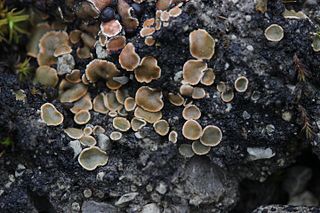
Psora is a genus of lichen-forming fungi in the family Psoraceae. Members of the genus are commonly called fishscale lichens. Lichens in the genus Psora generally have a squamulose thallus and anthraquinones in the hymenium. Photobiont partners of Psora lichens include members of the green algal genera Asterochloris, Chloroidium, Myrmecia, and Trebouxia.
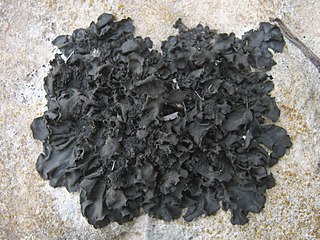
Collema is a genus of lichens in the family Collemataceae. The photobiont is the cyanobacterium genus Nostoc. Species in this genus typically grow on nutrient-rich bark or somewhat siliceous or calcareous rocks in humid environments.

The Arthoniaceae are a family of lichenized, lichenicolous and saprobic fungi in the order Arthoniales. The Arthoniaceae is the largest family of Arthoniales, with around 800 species. Most species in Arthoniaceae belong in Arthonia which is the largest genus with 500 species. The second and third largest genus is Arthothelium with 80 species, and Cryptothecia with 60 species.

The Collemataceae are a lichenized family of fungi in the order Peltigerales. The family contains ten genera and about 325 species. The family has a widespread distribution.

The Stereocaulaceae are a family of lichen-forming fungi in the order Lecanorales. It contains five genera. Species of this family are widely distributed in temperate boreal and austral regions.

Cerrena is a genus of poroid fungi in the family Polyporaceae. The genus was circumscribed by Samuel Frederick Gray in 1821. Gray's type species, Cerrena cinerea, is now known as C. unicolor.
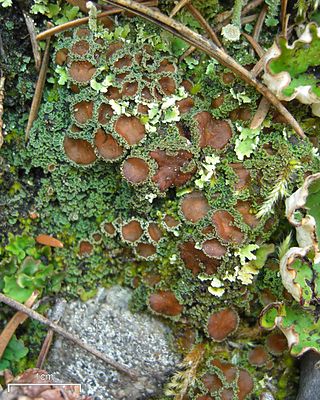
Psoroma is a genus of lichen-forming fungi in the family Pannariaceae. The widespread genus contains about 30 species, most of which are found in south temperate regions.
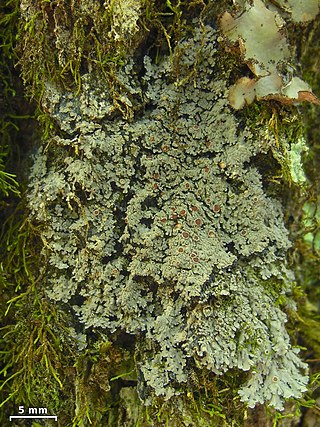
Fuscopannaria is a genus of lichen-forming fungi in the family Pannariaceae. It has 55 species.

Gyalecta is a genus of lichen-forming fungi in the family Gyalectaceae that contains 50 species. Gyalecta was circumscribed by lichenologist Erik Acharius in 1808. It forms associations with Trentepohlia algae.

Leptogium is a genus of lichen-forming fungi in the family Collemataceae. It has about 110 species. Species formerly classified under Leptogium have since been divided among the genera Leptogium, Pseudoleptogium, and Scytinium. Leptogium lichens are predominantly found on tree bark or soil, often among mosses, and sometimes on rocks in moist environments.
Arctomia is a genus of lichen-forming fungi in the family Arctomiaceae. The genus was originally circumscribed by Theodor Magnus Fries in 1861. Arctomia has a circumpolar distribution.
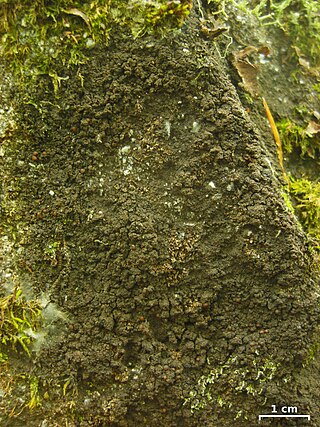
Vahliella is a genus of nine species of lichen-forming fungi in the order Peltigerales. It is the only member of Vahliellaceae, a family circumscribed in 2010 to contain this genus. Vahliella was formerly placed in the family Pannariaceae until molecular phylogenetics showed that it did not belong there. Vahliella species are found in the Northern Hemisphere – mainly in North America, but also in Europe and India.

Blennothallia is a genus of jelly lichens in the family Collemataceae. It has four species, which collectively have a cosmopolitan distribution.

Scytinium is a genus of lichen-forming fungi in the family Collemataceae. It has 49 species. These lichens are typically found on basic rocks, soil, and trees, occasionally in association with mosses. Despite the morphological and ecological diversity within Scytinium, its species share similar ascospore features, such as shape and septation, as well as a small to medium-sized thallus with at least a partial cortex.

Lathagrium is a genus of lichen-forming fungi in the family Collemataceae. It has 10 species of gelatinous lichens. Species in this genus typically grow on calcareous rocks, often amidst mosses, but can also be found on siliceous or serpentine rocks, mortar, or soil.
Nevesia is a monotypic genus of lichenized fungus in the family Pannariaceae. It contains the species Nevesia sampaiana. The genus name honors Carlos das Neves Tavares, the Portuguese lichenologist who first identified the species in 1950.

Rostania is a genus of lichen-forming fungi in the family Collemataceae. These lichens are primarily found on tree bark, occasionally on wood, with one species known to inhabit soil. The genus is characterized morphologically by having minute thalli made of hyphal tissue without a separate cortex, and the more or less cuboid-shaped ascospores.
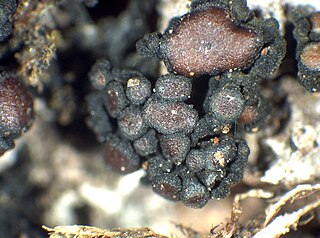
Enchylium conglomeratum, commonly known as dotted jelly lichen, is a species of foliose lichen in the family Collemataceae. Formerly known as Collema conglomeratum, it was renamed in 2013. This lichen has a fragmented distribution across the Holarctic region, occurring in both North America and Europe.

Enchylium polycarpon, commonly known as the shaly jelly lichen, is a species of foliose lichen in the family Collemataceae. Formerly known as Collema polycarpon, it was renamed in 2013 as part of a taxonomic revision. This lichen has a widespread global distribution, occurring in various regions of North America, Europe, Africa, and Asia.
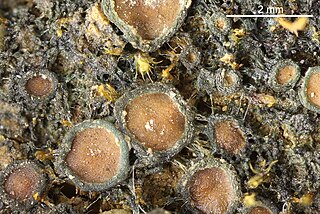
Enchylium limosum, commonly known as lime-loving tarpaper lichen, is a species of crustose to subfoliose lichen in the family Collemataceae. This unique lichen species possesses a gelatinous thallus with a dark coloration, contributing to its distinctive appearance. It thrives in a diverse array of habitats spanning temperate to boreal-montane regions, across Europe, North America, Africa, and Asia.


















